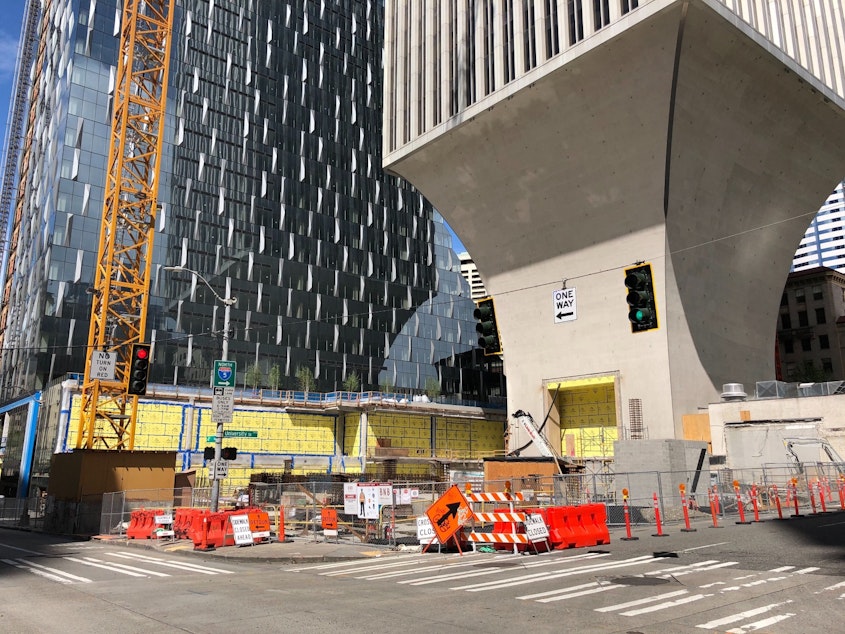Small builders jump on construction restart, big builders appear cautious

Construction activity in Washington restarted this week.
Governor Inslee said that if you can do your work six feet apart, if you wear a mask, and if someone on site is in charge of compliance, you can work. There are a few other criteria, too.
KUOW hit the road with a pair of binoculars to see what that looks like in practice.
I started by driving around in my neighborhood in Ballard. Here’s what I saw there: lots of small contractors working on single family homes or new townhomes. Plumbers, landscapers, carpenters. They wasted no time in responding to the governor’s proclamation. I noticed more traffic, too. While driving an arterial, I found myself behind a column of several Ford f150s, a popular truck among contractors.
To get a sense of how small contractors are getting ready to get back to work, I called Joseph Irons, who runs Iron Brothers Construction. His company has been squeaking along on a few projects deemed essential, but he’s enthusiastic to return to work at all jobsites.
But there’s some things they haven’t figured out yet. Like how to stay six feet apart – when it takes two people to lift something really heavy, like a granite countertop.
“Or putting a bathtub in place. How do we put somebody’s range in, or refrigerator in with one person and be safe,” he said. “We’re not talking about people lifting stuff in and out all day next to each other, but it does take 30 minutes to put a countertop down with people being periodically closer than 6 feet.”
Irons said he’s expecting further guidance on those questions from the Governor’s office later this week. But for now, he’s playing it safe – and avoiding those tasks.
As I drove by the Ballard Locks, I passed a road construction crew. The flaggers holding signs both had masks on. But the people scooping concrete down the chute at the back of the concrete truck weren’t. One man’s mask hung around his neck, the other’s hung loosely from one ear.
Concrete work is particularly challenging, because you can’t adjust a mask with concrete covered gloves. But later on my route, I saw an asphalt paving company crew gathered closely together, apparently having just finished a team meeting. None of them had masks on.
These crews are supposed to have somebody on site, making sure they’re compliant.
Kat Sims is the Executive Director of the Master Builders Association of King and Snohomish Counties. She’s worried about small companies not complying properly. Her organization has put together a "toolkit" of resources to help builders reopen correctly. She said they're proactively pursuing builders who aren't members of her organization in order to make sure the rules reach everyone.
“My advice to builders is if you cannot follow the health safety protocols, you have no business being on your construction site,” she said. “And if we backslide, from a health perspective, we will lose our ability to work.”
That could prove very costly to contractors for whom this reopening of their industry – offers a light at the end of a very dark financial tunnel. Jimmy Matta is emerging from a tunnel like that – as the owner of Ahora Construction, in Burien. He also happens to be the elected mayor of Burien, so he sees how a slowdown for business leads to a slowdown in government services to help people in need.
Matta explained that his construction business will survive the shutdown, but just barely. Normally, this time of year, he’d be starting to pick up larger jobs, gradually building up his company’s nest egg to help carry him through the annual slowdown in construction that comes each winter.
But instead, his crews have been out of work for weeks.
“So now, we’re going to ramp up,” he said. “I’ve got to buy materials, I’ve got to make sure I’m carrying my payroll for one week. And then, if in another month, the market closes down, and then all my money’s out, and all my credit accounts are maxed, how am I going to survive?” Kat Sims of Master Builders said she feared many small companies would not survive a second shutdown.
So far in my drive around town, I’d been looking at small jobsites. But downtown, projects are much bigger. So I set out to see if the activity I’d seen at smaller sites was also happening at larger sites.
I drove by several skyscraper projects. None of them showed any activity. I pulled over and peered through my binoculars at one. No one, except a security guard slowly walking around one site.
When driving past the new tower being built at Rainier Square, I glimpsed of a guy on a cell phone leaning out the backdoor. I pulled over, put on my mask, and looked for him, but he was gone, having retreated through a plywood door like a sea anemone retreating into its shell.
I walked around the whole site, which looked exactly like it had weeks ago when it first shut down: Bare rebar in the plaza, still exposed to the elements, waiting to be wrapped in formwork and concrete. A construction elevator that stayed on the ground floor. I saw no workers.
From this trip driving around Seattle, I learned that many small contractors are wasting no time getting back to work. But many big builders are still not ready to jump into this yet, at least not by the first business day after the governor cracked the door open for the construction industry.

